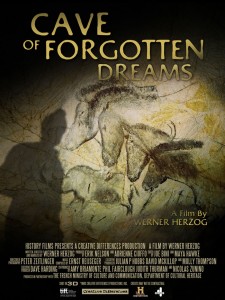 Leave it Werner Herzog to make one of the least technically-polished modern 3D films yet released, and the first truly unassailable entry in the medium. More importantly, he’s made another fine documentary about a fascinating subject in the well-known Herzog fashion with which many are familiar. That said, I’m very serious when I say that Herzog has made a documentary for which a proper 3D projection is essential to the film on a conceptual level.
Leave it Werner Herzog to make one of the least technically-polished modern 3D films yet released, and the first truly unassailable entry in the medium. More importantly, he’s made another fine documentary about a fascinating subject in the well-known Herzog fashion with which many are familiar. That said, I’m very serious when I say that Herzog has made a documentary for which a proper 3D projection is essential to the film on a conceptual level.
Returning to the simplicity of some of his older documentaries, Cave of Forgotten Dreams is the result of Herzog’s unprecedented –though still extremely limited– access to the Chauvet set of caves that house the oldest cave drawings that have been discovered in all of human history. A vast majority of the run-time of the film is dedicated to straightforwardly viewing said drawings, or watching the messy process of capturing them. The doc is one of those that manages to simultaneously be about its subject and about itself, something made clear when Herzog’s trademark narration essentially beings with an explanation of why the picture quality is so questionable, and why the crew members are often in shots.
The documentary isn’t entirely presented as a gallery of cave wall paintings- there is historic context and expert commentary woven into the narrative, along with a healthy dose of Herzog’s usual philosophical musings. Naturally these tend toward the profound and the melodramatic in such a way that makes you laugh aloud at the same time that you appreciate a beautiful metaphor or rhetorical question. Herzog coats his documentaries in his musings and accented narrations, so it’s typically impossible to divorce them from him and his amusingly serious meditations concerning what radioactive albino crocodiles will think of the paintings in 20,000 years.
This brings us back to the 3D though, and despite the fatigue that has set in for so many at even the mention of it, there’s no getting around how embedded 3D is to the texture of the film. The fact of the matter is that the paintings in question are housed on multi-dimensional surfaces that engage layers of depth no matter what angle they are viewed from. Right away the canvas of the documentary reflects the canvas on which the subject matter was created, and you have all the justification you might need. Stereoscopic 3D is most effective for close up subjects, as depth is only perceived on nearby objects (far away landscapes are flattened into 2D forms in real life). The texture and undulating curvature of the cave walls lend themselves perfectly to long, delicate shots that allow a viewer to marvel at the beauty of these paintings that none of us will ever see in person. It is safe to say that a 2D presentation does not capture the same wonder or sense of closeness, and Cave of Forgotten Dreams may be the first objectively successful 3D film.
As I mentioned above though, one can’t avoid mentioning that the tech itself is not the most well-implemented. Entirely a result of the impossibly limiting rules and restrictions of the cave shoot (which Herzog simply make a part of the narrative), the 3D is rough around the edges (sometimes literally) and the edit often disregards any consideration of convergence shifts. That said, this doesn’t feel any different than when documentaries are forced to employ low-res footage, poorly recorded audio, or any other technically flawed source material that is necessary to retain for story purposes. The 3D footage is often perfect and beautiful though, and that’s always the case when it really counts.
It took 30,000 year old cave paintings and an intrepid German documentarian to find it, but a proper example of necessary 3D has been found. The director may never have worked in the format before and will likely never do so again, but he’s certainly left his mark by sharing with us the wonder of a truly beautiful landmark in ancient human history, in a much more profoundly impressive way than traditional cinema could offer.
Rating: 




Out of a Possible 5 Stars